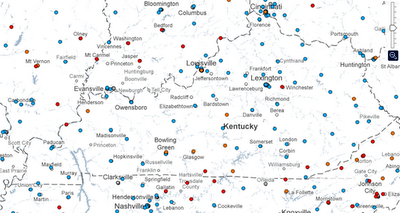Despite the risk of exposing patients to more radiation and the fact that radiologists say it is very rarely necessary, Medicare outpatients are regularly receiving two CT scans on the same day at 12 Kentucky hospitals, according to analanysis of Medicare data by
The New York Times, which produced a handy interactive map, a segment of which is copied here. To use the actual map, click on the map below.
Though only 5.4 percent of hospitals nationwide scan a patient’s chest twice on the same day, nine Kentucky hospitals are double-scanning at least 15 percent of the time and three are doing it more than 30 percent of the time, accoding to data for 2008. Figures for 2009, which are expected to be similar, are due out next month from the federal Center for Medicare and Medicaid Services.
Clark Regional Medical Center in Winchester has the highest rate, double scanning 43 percent of the time. Monroe County Medical Center in Tompkinsville double scans 34 percent of the time, followed by Pineville Community Hospital at 32 percent.
Other Kentucky hospitals that are double scanning at least 15 percent of the time include:
Clinton County Hospital, Albany, 30 percent;
Paul B. Hall Regional Medical Center, Paintsville, 25 percent;
Harlan Appalachian Regional Healthcare Hospital, 24 percent;
Norton Hospitals, Louisville, 23 percent;
Westlake Regional Hospital, Columbia, 23 percent;
Spring View Hospital, Lebanon, 20 percent;
Methodist Hospital Union County, Morganfield, 19 percent;
T.J. Samson Community Hospital, Glasgow, 18 percent; and
The Medical Center at Bowling Green, 18 percent.
There are two types of CT scans, one that uses iodine contrast to monitor blood flow and one that does not. In rare circumstances, performing both scans — each with a separate charge — could help spot a tumor, said Dr. Michael J. Pentecost, a radiologist and Medicare consultant. While doctors may opt to double scan to get the most information on their patient possible, experts say being so thorough is rarely necessary, particularly given the added cost to the system and the exposure to radiation for the patient.
As Kentucky’s numbers indicate, double scanning happens more often at small, community hospitals, where treatment can involve transferring patients to larger facilities. Nationwide, 200 hospitals administered double scans more than 30 percent of the time.
The Medicare agency released the data last year to hospitals “to show how they performed relative to each other and to encourage more efficient, safer practices,” Walt Bogdanich and Jo Craven McGinty of the Times report. “The Medicare agency believes hospitals can and should do more to change physician behavior … The federal agency plans to use other, similar measurements to rein in what it considers to be unjustified — and potentially dangerous — medical procedures.” (
Read more)

